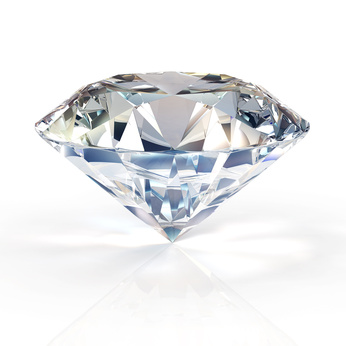Before you buy any diamond, you should first inspect it carefully under magnification. To that end, it is best to use a 10x loupe or a jeweler’s microscope. Taking a close look at the stone will help you to spot any potential problems or defects that may not be readily visible with the naked eye.
What You Should Be Looking For
So, what should you be looking for when inspecting a diamond with a loupe?
At the very least, you should check if there are any flaws that can weaken the diamond’s structure, look for signs that the stone has undergone clarity enhancement, and see if the diamond has a laser inscription.

Most Important Types of Inclusions to Check For
There are different types of inclusions, and some can be more harmful, while others can be annoying but harmless.
For example, black dots tend to be more visible, but they do not pose any significant threat to the integrity of the diamond.
The inclusions you should be on the lookout for are the ones that look like cracks or lines.
If they are big enough, they can weaken the structure of the stone.
Be especially wary of lines that run through most of the stone and are close to the surface. Such inclusions are weak spots that could cause the diamond to crack if hit hard enough.
Check the surface of the stone for chips. The ones that can create problems are those that are bigger and more visible. Keep in mind that a chip weakens the area where it is located, and a stronger bump there can cause the stone to chip further.
If the stone comes with a certificate, it should contain a diagram of the diamond showing all its visible inclusions.
You can use this diagram as a map and check if the flaws showed on it match the ones you can see when inspecting the actual stone. This is yet another way to make sure that the certificate describes the same diamond you have.
Click here to inspect real diamonds with a 360-degree virtual loupe.
How to Spot Signs of Clarity Enhancement
Check the stone for signs of clarity-enhancing procedures such as laser drilling or fracture filling.
Laser-drilled diamonds have very thin channels inside them, and they should be visible at close inspection under magnification.
These channels were used to get to an inclusion inside the stone and dissolve it with heat or acid. You can see these spots as small hollows that have remained after the flaw was removed.
Sometimes, these laser-drilled channels and hollow spaces are filled with a glass-like substance in a process called fracture filling. The filling reflects light differently from the rest of the diamond and should be easy to spot with a loupe.
The tunnels drilled in a clarity-enhanced diamond are not problematic unless they are numerous, in which case they might weaken the stone, especially if the flaws removed also took up a lot of space.
Fracture-filled diamonds are more problematic because the filling can melt or crack if the piece of jewelry that the stone is set in is repaired using heat.
In general, it is always a good idea to check for signs of clarity-enhancing procedures because sometimes they are not disclosed.
Checking the Diamond’s Laser Inscription
Many diamonds that are certified come with a laser inscription, which is a number (or a combination of numbers and letters) that serves as a unique identifier for the stone. This number is usually inscribed with laser on the diamond’s girdle.
To verify whether the diamond you have purchased is the same as the one described in the grading certificate, look at the stone under magnification and try to make out its laser inscription. If there is one, it should match the diamond ID printed on the certificate.
Where to Buy Diamond Jewelry?
We recommend James Allen (read review) because you can see a 360-degree video for any diamond before buying it.
Blue Nile is another reputable diamond retailer we recommend.














